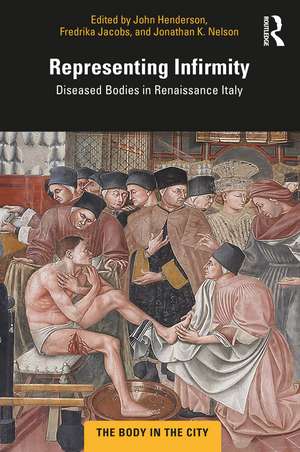Representing Infirmity: Diseased Bodies in Renaissance Italy: The Body in the City
Editat de John Henderson, Fredrika Jacobs, Jonathan K. Nelsonen Limba Engleză Paperback – 18 noi 2020
Looking beyond the modern category of ‘disease’ and viewing infirmity in Galenic humoral terms, each chapter explores which infirmities were depicted in visual culture, in what context, why, and when. By exploring the works of artists such as Caravaggio, Leonardo, and Michelangelo, this study considers the idealized body altered by diseases, including leprosy, plague, goitre, and cancer. In doing so, the relationship between medical treatment and the depiction of infirmities through miracle cures is also revealed. The broad chronological approach demonstrates how and why such representations change, both over time and across different forms of media. Collectively, the chapters explain how the development of knowledge of the workings and structure of the body was reflected in changed ideas and representations of the metaphorical, allegorical, and symbolic meanings of infirmity and disease.
The interdisciplinary approach makes this study the perfect resource for both students and specialists of the history of art, medicine and religion, and social and intellectual history across Renaissance Europe.
| Toate formatele și edițiile | Preț | Express |
|---|---|---|
| Paperback (1) | 248.35 lei 6-8 săpt. | |
| Taylor & Francis – 18 noi 2020 | 248.35 lei 6-8 săpt. | |
| Hardback (1) | 767.93 lei 6-8 săpt. | |
| Taylor & Francis – 18 noi 2020 | 767.93 lei 6-8 săpt. |
Preț: 248.35 lei
Preț vechi: 296.84 lei
-16% Nou
Puncte Express: 373
Preț estimativ în valută:
47.53€ • 48.67$ • 39.54£
47.53€ • 48.67$ • 39.54£
Carte tipărită la comandă
Livrare economică 19 martie-02 aprilie
Preluare comenzi: 021 569.72.76
Specificații
ISBN-13: 9780367470203
ISBN-10: 0367470209
Pagini: 272
Ilustrații: 19 Halftones, color; 45 Halftones, black and white
Dimensiuni: 156 x 234 x 17 mm
Greutate: 0.5 kg
Ediția:1
Editura: Taylor & Francis
Colecția Routledge
Seria The Body in the City
Locul publicării:Oxford, United Kingdom
ISBN-10: 0367470209
Pagini: 272
Ilustrații: 19 Halftones, color; 45 Halftones, black and white
Dimensiuni: 156 x 234 x 17 mm
Greutate: 0.5 kg
Ediția:1
Editura: Taylor & Francis
Colecția Routledge
Seria The Body in the City
Locul publicării:Oxford, United Kingdom
Public țintă
Postgraduate and Undergraduate AdvancedCuprins
Part 1: Approaches to the representation of infirmity 1 Cancer in Michelangelo’s Night. An analytical framework for retrospective diagnoses 2 The language of medicine in Renaissance preaching 3 Representing infirmity in early modern Florence Part 2: Institutions and visualising illness 4 On display: poverty as infirmity and its visual representation at the hospital of Santa Maria della Scala in Siena 5 The friar as medico: picturing leprosy, institutional care, and Franciscan virtues in La Franceschina Part 3: Disease and treatment 6 The drama of infirmity: cupping in sixteenth-century Italy 7 Suffering through it: visual and textual representations of bodies in surgery in the wake of Lepanto (1571) 8 Artistic representations of goitre in early modern art in Italy Part 4: Saints and miraculous healing 9 Infirmity in votive culture: a case study from the sanctuary of the Madonna dell’Arco, Naples 10 Infirmity and the miraculous in the early seventeenth century: the San Carlo cycle of paintings in the Duomo of Milan 11 Epilogue: did Mona Lisa suffer from hypothyroidism? Visual representations of sickness and the vagaries of retrospective diagnosis
Notă biografică
John Henderson, Professor of Italian Renaissance History, Department of History, Classics and Archaeology, Birkbeck, University of London. His most recent books include The Renaissance Hospital: Healing the Body and Healing the Soul (2006) and Florence under Siege: Surviving Plague in an Early Modern City (2019).
Fredrika Jacobs, Professor Emerita, Virginia Commonwealth University. She is the author of Defining the Renaissance 'Virtuosa': Women Artists and the Language of Art History and Criticism, The Living Image in the Renaissance, and Votive Panels and Popular Piety in Early Modern Italy. Her current project is ‘10 objects + a shadow’.
Jonathan K. Nelson, Teaching Professor, Syracuse University Florence. His books include The Patron’s Payoff: Conspicuous Commissions in Italian Renaissance Art (with Richard Zeckhauser), Bad Reception: Negative Reactions to Italian Renaissance Art (co-editor; forthcoming), and monographic studies of Leonardo da Vinci, Filippino Lippi (with Patrizia Zambrano), Michelangelo, Plautilla Nelli, and Robert Mapplethorpe.
Fredrika Jacobs, Professor Emerita, Virginia Commonwealth University. She is the author of Defining the Renaissance 'Virtuosa': Women Artists and the Language of Art History and Criticism, The Living Image in the Renaissance, and Votive Panels and Popular Piety in Early Modern Italy. Her current project is ‘10 objects + a shadow’.
Jonathan K. Nelson, Teaching Professor, Syracuse University Florence. His books include The Patron’s Payoff: Conspicuous Commissions in Italian Renaissance Art (with Richard Zeckhauser), Bad Reception: Negative Reactions to Italian Renaissance Art (co-editor; forthcoming), and monographic studies of Leonardo da Vinci, Filippino Lippi (with Patrizia Zambrano), Michelangelo, Plautilla Nelli, and Robert Mapplethorpe.
Recenzii
From the press:
Does Michelangelo's Night have breast cancer? The essay by the art historian Nelson leaves no doubts and reopens the dispute (https://www.ilfattoquotidiano.it/2020/12/05/la-notte-di-michelangelo-ha-un-tumore-al-seno-il-saggio-dello-storico-dellarte-nelson-non-lascia-dubbi-e-riapre-la-disputa/6025033/)
Does Michelangelo's Night have breast cancer? The essay by the art historian Nelson leaves no doubts and reopens the dispute (https://www.ilfattoquotidiano.it/2020/12/05/la-notte-di-michelangelo-ha-un-tumore-al-seno-il-saggio-dello-storico-dellarte-nelson-non-lascia-dubbi-e-riapre-la-disputa/6025033/)
Descriere
This volume is the first in-depth analysis of how infirm bodies were represented in Italy from c.1400-1650. Through original contributions and methodologies, it addresses the fundamental yet undiscussed relationship between images and representations in medical, religious, and literary texts.




